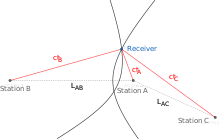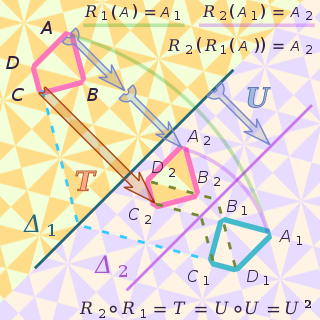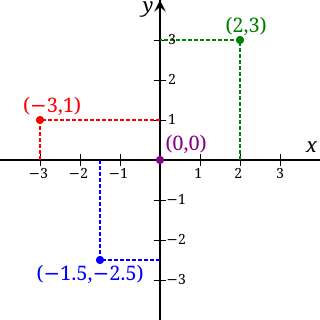Cayley–Menger determinants
Cayley–Menger determinants, named after Arthur Cayley and Karl Menger, are determinants of matrices of distances between sets of points.
Let  be n + 1 points in a semimetric space, their Cayley–Menger determinant is defined by
be n + 1 points in a semimetric space, their Cayley–Menger determinant is defined by

If  , then they make up the vertices of a possibly degenerate n-simplex
, then they make up the vertices of a possibly degenerate n-simplex  in
in  . It can be shown that [6] the n-dimensional volume of the simplex
. It can be shown that [6] the n-dimensional volume of the simplex  satisfies
satisfies

Note that, for the case of  , we have
, we have  , meaning the "0-dimensional volume" of a 0-simplex is 1, that is, there is 1 point in a 0-simplex.
, meaning the "0-dimensional volume" of a 0-simplex is 1, that is, there is 1 point in a 0-simplex.
 are affinely independent iff
are affinely independent iff  , that is,
, that is,  . Thus Cayley–Menger determinants give a computational way to prove affine independence.
. Thus Cayley–Menger determinants give a computational way to prove affine independence.
If  , then the points must be affinely dependent, thus
, then the points must be affinely dependent, thus  . Cayley's 1841 paper studied the special case of
. Cayley's 1841 paper studied the special case of  , that is, any five points
, that is, any five points  in 3-dimensional space must have
in 3-dimensional space must have  .
.
Characterization via Cayley–Menger determinants
The following results are proved in Blumethal's book. [12]
Embedding n + 1 points in the real numbers
Given a semimetric space  , with
, with  , and
, and  ,
,  , an isometric embedding of
, an isometric embedding of  into
into  is defined by
is defined by  , such that
, such that  for all
for all  .
.
Again, one asks whether such an isometric embedding exists for  .
.
A necessary condition is easy to see: for all  , let
, let  be the k-simplex formed by
be the k-simplex formed by  , then
, then

The converse also holds. That is, if for all  ,
,

then such an embedding exists.
Further, such embedding is unique up to isometry in  . That is, given any two isometric embeddings defined by
. That is, given any two isometric embeddings defined by  , and
, and  , there exists a (not necessarily unique) isometry
, there exists a (not necessarily unique) isometry  , such that
, such that  for all
for all  . Such
. Such  is unique if and only if
is unique if and only if  , that is,
, that is,  are affinely independent.
are affinely independent.
Embedding n + 2 and n + 3 points
If  points
points  can be embedded in
can be embedded in  as
as  , then other than the conditions above, an additional necessary condition is that the
, then other than the conditions above, an additional necessary condition is that the  -simplex formed by
-simplex formed by  , must have no
, must have no  -dimensional volume. That is,
-dimensional volume. That is,  .
.
The converse also holds. That is, if for all  ,
,

and

then such an embedding exists.
For embedding  points in
points in  , the necessary and sufficient conditions are similar:
, the necessary and sufficient conditions are similar:
- For all
 ,
,  ;
; 


Embedding arbitrarily many points
The  case turns out to be sufficient in general.
case turns out to be sufficient in general.
In general, given a semimetric space  , it can be isometrically embedded in
, it can be isometrically embedded in  if and only if there exists
if and only if there exists  , such that, for all
, such that, for all  ,
,  , and for any
, and for any  ,
,



And such embedding is unique up to isometry in  .
.
Further, if  , then it cannot be isometrically embedded in any
, then it cannot be isometrically embedded in any  . And such embedding is unique up to unique isometry in
. And such embedding is unique up to unique isometry in  .
.
Thus, Cayley–Menger determinants give a concrete way to calculate whether a semimetric space can be embedded in  , for some finite
, for some finite  , and if so, what is the minimal
, and if so, what is the minimal  .
.





























































































